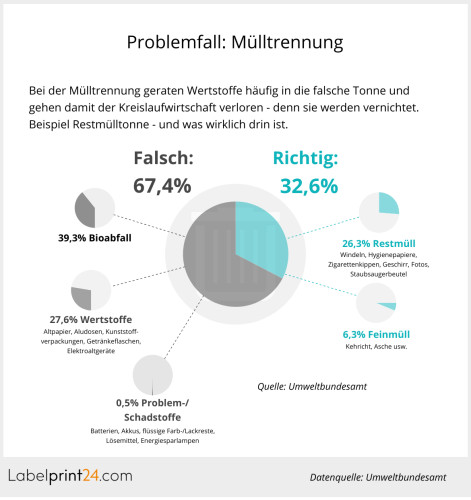
Sustainable inks and pigments for packaging printing
- Brand manufacturers expect unique and high-quality packaging products but are increasingly looking at sustainability in packaging printing.
- Printing processes and production can be made more sustainable in many ways - but how can this be achieved with the printing processes themselves?
- Inks and pigments must not only be visually convincing, but their impact on recycling also has to be taken into account. They, therefore, have to not only protect packaged foods, for example, but the environment as well.
- Different printing inks, different recycling results: Overall, however, manufacturers are paying more attention to ensuring better recycling of their printing inks and the associated packaging products.
When it comes to packaging and the topic of sustainability, the focus is usually on the materials used. But these are only one aspect of many: The inks and pigments used in packaging printing also play a major role. Because these have to meet strict specifications, especially in the food sector - and can be composed more sustainably at the same time.
This is what modern packaging printing has to deliver
Brand manufacturers are quite demanding when it comes to their packaging printing requirements. This applies to the quality of the printed products just as much as to sufficient flexibility to be able to fulfil special wishes. And of course, the sustainability factor is also increasingly important.
Printing solutions for every need
Packaging is an important figurehead for branded products. After all, they have to be convincing in direct customer contact in the shop and, if possible, outdo the competition. Accordingly, all the possibilities that packaging printing has to offer are exhausted:
- Flexible offers: Companies that have printed packaging in long runs usually rely on intaglio printing. However, when it comes to smaller print runs with individualised imprints, digital printing remains the first choice.
- Noble appearance, pleasant feel: Bright colours, metallic elements or partial (matt) coating - brand manufacturers have clear ideas about the appearance and use every printing and finishing technique that can create a unique look. Particularly as this can also achieve a pleasant feel.
.jpg)
Making packaging printing more sustainable - but how?
When it comes to sustainability, the principle of “reduction” prevails among brand manufacturers. For example, through minimalist packaging designs that make do with less ink. The focus is also on more sustainable materials and printing processes
In fact, changes and savings are possible all around the printing process. More efficient equipment with short makeready times, better filters for chemicals or better regeneration for developer solutions help save resources at many points in production.
Nevertheless, the most important working material in the printing industry – ink - remains a central factor in sustainability. In sensitive areas (such as contact with foods), ink has to meet the highest standards of health safety anyway. But does that automatically make it harmless to the environment?
.jpg)
Better safe than sorry: printing inks and pigments in sensitive areas
A sensitive area where printing inks and pigments are used is food packaging. Especially when the ink comes into direct contact with the food. Packaging for food must therefore be produced according to clear legal requirements. They should:
- not release any ingredients or constituents into the packaged food that pose a health risk to consumers;
- not cause an unacceptable change in the taste, smell, etc. of the food;
- only be produced in accordance with the requirements of good manufacturing practice (GMP).
To ensure that these requirements are met, there is a whole series of regulations and laws at both European and national levels. These include e.g the Food and Feed Code(In German: “Lebensmittel- und Futtermittelgesetzbuch”), the Commodities OrdinanceIn German: “Bedarfsgegenständeverordnung”) or the EC Framework Regulation (1935/2004) for materials and articles that come into contact with food. What is still missing, however, is a unified regulation for printing inks on food packaging. The European Commission has, however, had a current draft of the so-called Printing Inks Regulation since 2020.
Apart from this, there are, of course, guidelines and test specifications formulated by, amongst others, the German Paint and Printing Ink Industry Association (In German: “Verband der deutschen Lack- und Druckfarbenindustrie e.V.”) (VdL). In addition, the European Printing Ink Association EuPIA also supports initiatives to improve the recycling of printed paper and cardboard packaging, for example - in the sense of less negative impact on the environment. After all, it is also a sensitive area that needs to be protected.
Since 1996, the European printing ink industry has committed itself to a common voluntary exclusion policy. This concerns certain raw materials that should not be used in the manufacturing of printing inks and related products.
The decisive factors for this exclusion policy are health protection and product safety. Manufacturers should be guided by the guidelines of good manufacturing practice.
That’s how printing inks and pigments can become more sustainable
More sustainable printing processes that use fewer resources, for example, are only one side of the coin. When it comes to opportunities for more sustainability in packaging printing, a central question must therefore be: How can printing inks and pigments contribute to this goal? There are various approaches to this.
Environmentally friendly inks - there’s more to it than that
When it comes to more environmentally friendly printing inks, it is not enough to look only at the finished product. Instead, a holistic view is needed that
- takes the entire product cycle from development to disposal as well as
- all related products (primer, sealing wax, overprint varnishes and washing materials) into account.
This is an extensive task because undesirable environmental impacts can occur at many points between ink production, the printing process and disposal. In other words, it cannot just be a question of all the components of printing ink being environmentally compatible and sustainable. Ideally, they also contribute to more ustainable processing – less energy consumption in drying, less chemical input in recycling and much more.
Renewable raw materials for offset inks
Offset printing inks account for around 40 per cent of European printing ink demand. Most of these inks now do not contain synthetic, mineral oil-based binders. Instead, vegetable oils and tree resins are increasingly being used in production.
As welcome as the return to renewable raw materials or printing inks is (they were already used in the early days of letterpress printing): Here, too, possible ecological consequences cannot be ruled out. Especially with regard to the agricultural cultivation methods of the required oil plants.
Fertilisers, pesticides and land consumption depress the positive eco-balance. Thus, the ecological advantage over crude oil products is shrinking.
Water-based printing inks for packaging
Another approach is to use water-based printing inks that do not contain solvents. In principle, this is already an advantage because it makes the ink more compatible for people and the environment, at least during manufacturing and production. For example, because only small amounts of volatile organic compounds escape during drying. However, depending on the substrate, drying can require more energy than with solvent-based inks. This is especially the case on plastics or metals. In addition, water-based inks often still cause difficulties in the recycling process, especially in the recycling of paper and cardboard packaging.De-inking is the process of removing ink from paper. The process is part of preparing printed waste paper for recycling. The disadvantage: this only works by using various chemicals (such as surfactants, hydrogen peroxide, etc.). They represent a potential environmental burden. De-inking is therefore not entirely unproblematic.
This is primarily because the inks can only be insufficiently separated from the paper fibres – and then literally leave their mark. The so-called “dirt specks” prevent the creation of high-quality recycling materials. However, the better “de-inkability” of printing inks has been a criterion for recyclability for some years now, for example, according to the requirements for the European Eco-label for printed products. Therefore, many ink manufacturers are working on solutions that are more recyclable.
Compostable pigments
Composting is now increasingly being cited as an alternative to conventional recycling options. Especially so-called bio-plastics could be recycled in a completely new way.In practice, this has so far proved difficult.Composting only works under very special conditions actually only industrial composting plants can provide. Moreover, it is not enough to develop compostable plastic as packaging: The EN 13432 regulation for proof of compostability stipulates that all components must be tested. This includes colours, adhesives, labels and even the contents of the packaging.
.jpg)
Pigments are considered additives in this context and must not interfere with the composting process. This can only succeed with the right pigment chemistry, which is sought at BASF among others
In principle, colouring the bioplastics is not a problem at all. The decisive factor is rather that, for example, the limit value of 1 per cent for non-biodegradable additives in the packaging is not exceeded. Additives already available that meet the criteria for compostable bioplastics are currently still too expensive for widespread use in packaging printing.
These articles might also interest you:

Label printing on foil and paper
Depending on the area of application and external conditions to which the labelled product is exposed in the course of its use, the properties of the materials used in a label printing shop differ.

Flashes when printing labels
After the labels have been printed, the adhesive labels are punched out of the material roll with the help of a cutting die or a laser punch. If the print motif is to end exactly on the later label edge, small, white edges can arise - the so-called flashes.

Label printer Germany - Labelprint24
We, Labelprint24 are one of the leading German e-commerce specialists for labels and many other packaging products. In the printing industry, we have earned an image as one of the most innovative label manufacturers in Germany.








 Roll labels request form
Roll labels request form  Booklet labels request form
Booklet labels request form  Folding boxes request form
Folding boxes request form  Custom made shipping boxes request form
Custom made shipping boxes request form  Package leaflets request form
Package leaflets request form  Laminate tubes request form
Laminate tubes request form 



















